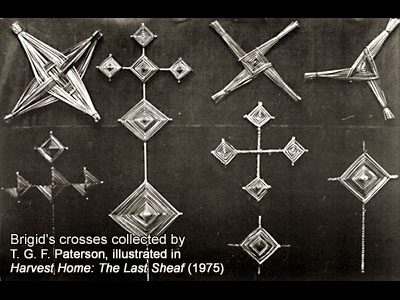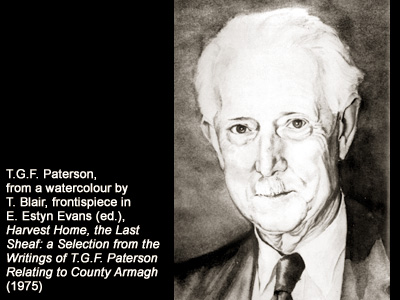

from T. G. Patterson, Harvest Home: The Last Sheaf (Dundalgan Press, 1975). pp. 193-196.
HARVEST KNOTS
Although the making of harvest knots is rarely practised in these days of the
mechanical reaper and binder, I have found that the custom is still continued
in some parts of County Armagh. Various types of knots are to be found in different
parishes, some being more ornate than others. In days past the girls wore their
knots in their hair, and it was usual for them to incorporate the heads of the
grain, whereas the men wore simple knots without any such appendages. It is
clear, however, that the harvest knots though worn at the cutting of the calliagh
(the last sheaf), were not made specially for that ceremony. There is indeed
ample evidence that they were worn on or before the actual cutting of the corn
and for some time after, and that they were formerly exchanged between the sexes
as a token of admiration or love. One young man, wearing a handsome and rather
unusual knot, on being questioned as to who made it, replied: " My sister."
In conversation I learned that he lived near, whereupon I said: "I shall
call and have your sister teach me to make that particular knot." He then
became much confused, and eventually blushingly confessed that it was "a
gift from a girl." The custom is fast dying out, hastened, no doubt, by
the fact that machinery now does the work of lifting and binding, tasks undertaken
almost exclusively by the womenfolk of half a century ago.
The making of the knot is simple but tricky. Two straws of fairly equal length and thickness are chosen. Two ends are fastened, usually the thinner ends, and the process begins. It consists of turning one straw over the other, taking care to release and rotate the tied straws between the finger and thumb, so that the uppermost straw becomes the bottom straw and is, in turn, bent over its counterpart. This continues until the straws are ready for knotting, which is an easy task.
BRIGID'S CROSSES
The making of Brigid's Crosses in County Armagh is falling rapidly into decay.
It seems sad that a custom that possibly was already ancient when Brigid was
born should now, some fourteen centuries later, be in grave danger of fading
from the memory of the people of the diocese of her nativity.


In County Armagh, in homes where the old custom lingers on, and they are few, the rushes are gathered on the last day of January and brought into the house. They must be pulled and on no account cut. As a rule, they are not taken inside until after sunset. On that evening it is usual to have a special meal, in which pancakes figure. This mostly takes place before the rushes are brought in, and when it is eaten a female member of the household is chosen to bring the rushes into the house. She is sent out into the darkness of the night and the door is carefully closed. She lifts the prepared rushes from some convenient spot near the door, knocks three times, and cries: "Go on your knees, open the door and let Brigid in." The door is then opened and all kneel in prayer, after which the rushes are divided and the household begins its task of making the crosses.
The ritual of the making of the crosses seems to vary somewhat in different districts. I have been told of a cross being fashioned and placed upon the table before the meal was partaken of. The meal itself is generally spoken of as "Brigid's Tea" or " Brigid's Supper," and though pancakes feature as the chief dish I have heard of apples being carefully saved (in the Baronies of O'Neiland) for that particular evening to make an apple griddlecake or an apple dumpling.
In County Armagh the Brigid's Cross now seldom appears as a straw cross. It is almost invariably made of rushes, though some varieties are chiefly fashioned from reeds. The making of straw crosses presents a rather perplexing problem. It suggests that the cult of the saint may have been in some way linked with the harvest in days past. I know of no reason for such a connection, but I remember seeing in the R. J. Welch collection of photographs a handsome straw cross, decorated with sixteen harvest knots. Such a cross presents to the mind a relationship with the harvest and makes one wonder whether Brigid took some of the attributes of the calliagh besides those of her pagan namesake.
The rush cross is sometimes varied by having weather-exposed rushes of the previous year intermixed with the new green rushes. This provides a pleasant contrast of colour but, of course, the cross eventually bleaches to a straw colour, and the effect is not then noticeable. There are many patterns of Brigid's Crosses, those most common in County Armagh being shown in the illustration. (Pl. V) The plaited varieties and interlaced types are not nearly so frequently seen. Some kinds are common to most of the parishes throughout the county and are equally well known in adjoining parts of the adjacent counties of Tyrone, Antrim, Down, Louth and Monaghan. The more ornate types seem to be elaborations of the simple forms. The three-legged cross is now rarely seen. It was specially reserved for the farm out-offices, animals and birds being specially dear to the saint in her lifetime and figuring in some of the most charming stories of her life.
In the days when most of our country cottages were devoid of ceilings, the inner side of the thatched roof was considered the proper place for the crosses of preceding years, and they usually remained there until they crumbled away. Many years ago I saw in South Armagh a ruined house with a few such crosses, black with age and exposure, still adhering to a portion of the thatch that had not fallen. It was then I first heard of that method of disposal. I have never seen crosses so preserved in the interior of an inhabited house, but I have seen the outer thatch used for that purpose. It is probable that the custom of utilizing the under-side of the thatched roof has become impracticable owing to the fact that the thatched interiors of almost all the old houses now have sacking or canvas tacked to the roof, which, when whitewashed, forms an inexpensive ceiling.
Brigid's Crosses, when fashioned, must not be lightly thrown aside. When they can no longer be preserved they should be burnt or buried. Whether the former procedure is a link with the "Perpetual Fire" established by Brigid at Kildare is far from clear, as also the reasons for their inhumation, but I have been informed in several localities that the latter method of disposal conveyed the saint's blessing to the crops.
Though it is thought more proper to make the crosses on Brigid's Eve or Brigid's Day, they are often made for presentation to friends. The making and giving of such crosses is said to honour Saint Brigid and confer a blessing on the person who made them, their welfare being increased by the gift of bestowal, and friendships strengthened between the donors and recipients.